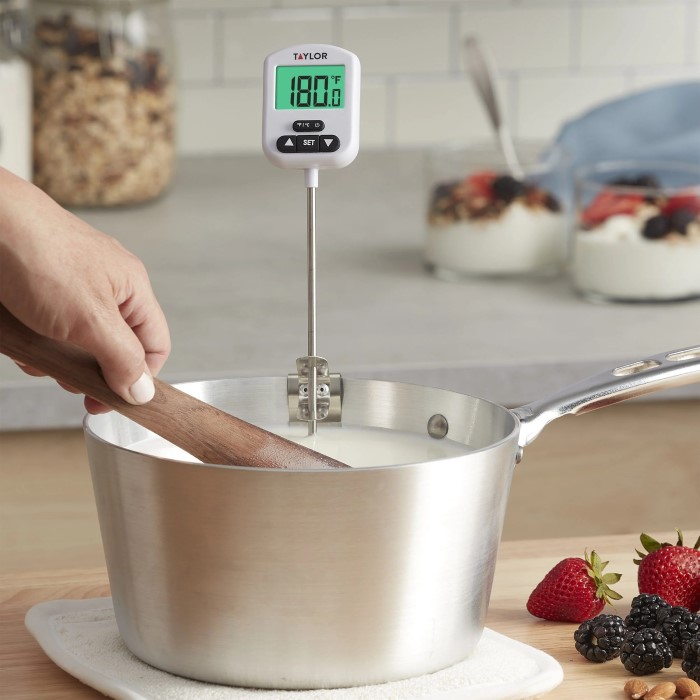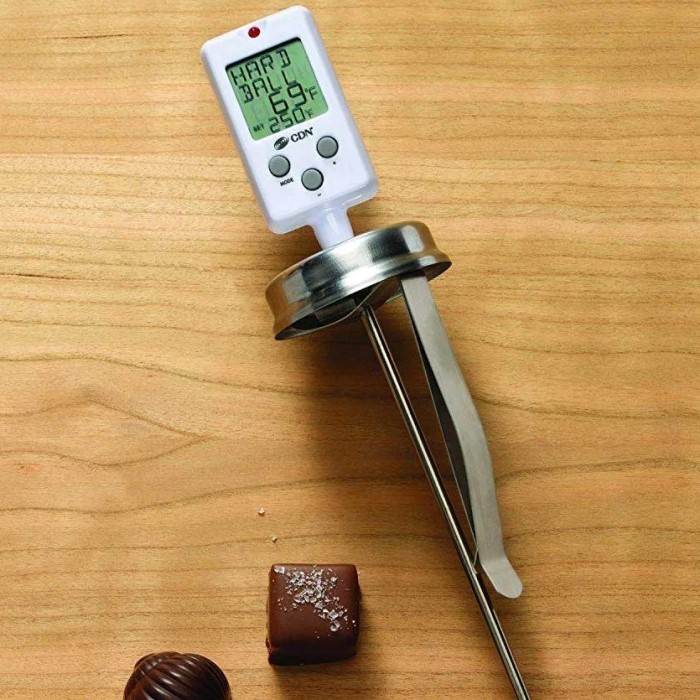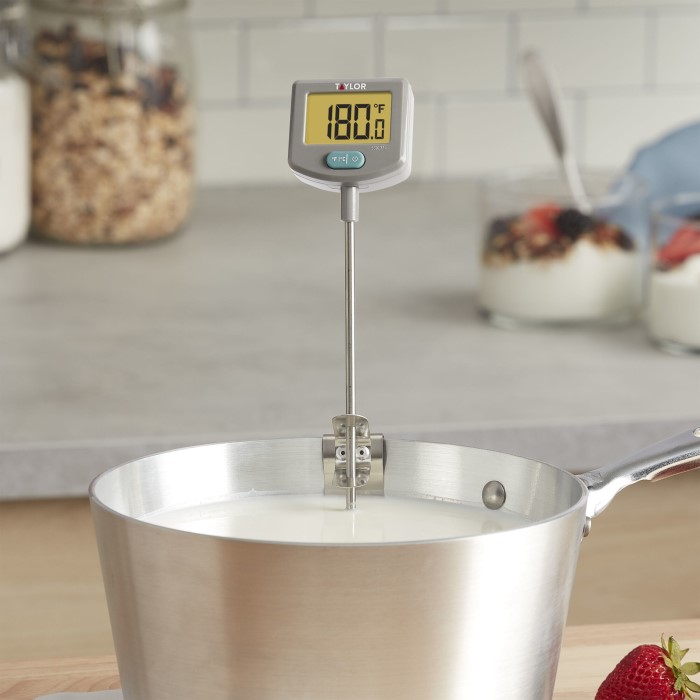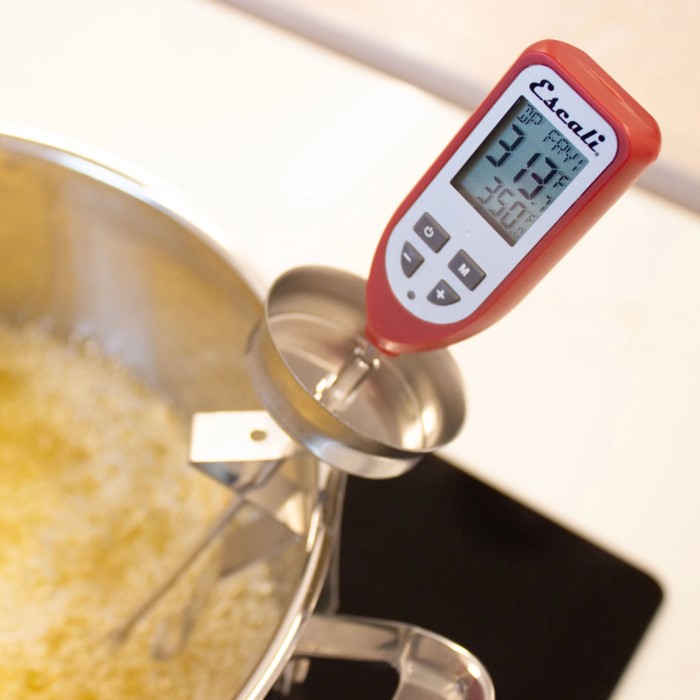What is a Digital Candy Thermometer?
A digital candy thermometer is a device used to measure the temperature of candy mixtures. It provides precise heat readings, making it ideal for achieving desired sweetness and texture during candy making. The digital display shows the temperature in real time, ensuring accuracy.
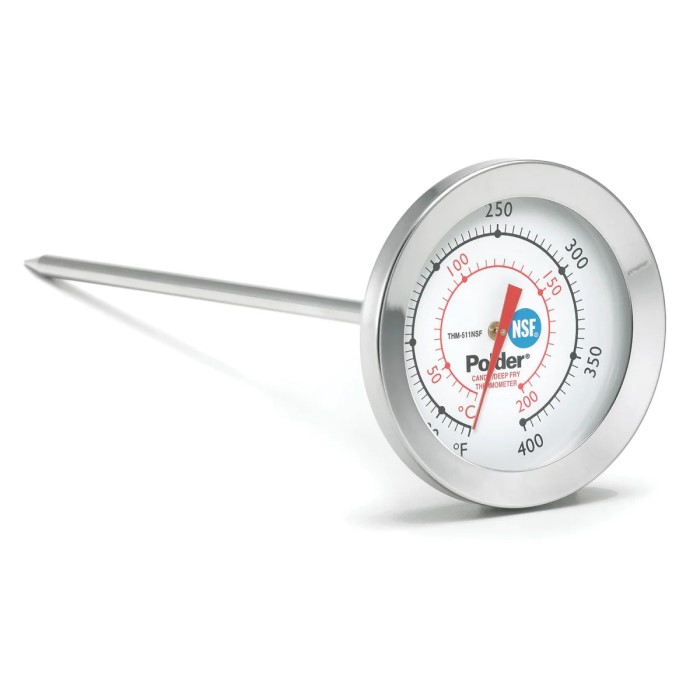
How it Differs from Other Thermometers
Digital candy thermometers are specifically designed for high-temperature readings in cooking stages. Unlike standard food thermometers, they can handle the extreme heat required for candy-making without breaking. They also usually feature longer probes for safer handling with hot mixtures.
Another key difference is their precision. General thermometers may not provide readings accurate enough for candy-making processes, but digital models excel in this area. They also often include features such as clips to attach securely to pots, which standard thermometers might lack.
Key Features of a Digital Candy Thermometer
- Digital Display: A clear, easy-to-read screen shows exact temperature readings.
- Wide Temperature Range: Designed to measure temperatures up to 400°F (or higher) for candy stages.
- Clip-On Design: Many models include clips for hands-free monitoring.
- Fast Response Time: Reacts quickly to temperature changes for accurate readings.
- Safety Features: Includes long probes and heat-resistant materials to protect users.
- Durability: Built from sturdy materials to endure high heat and frequent use.
These features make digital candy thermometers indispensable for precise and safe candy-making. They simplify the process and reduce errors, ensuring perfect results every time.
Why is Accuracy Important in Candy Making?
Precision is crucial in candy making. Accurate temperatures ensure the desired consistency and flavor. A digital candy thermometer helps achieve this precision. It reduces the risk of overcooking or undercooking mixtures.
The Role of Temperature in Candy Consistency
Temperature directly affects the texture of candy. Different stages require precise heat levels:
- Soft Ball Stage (235–245°F): Produces soft, chewy candy like fudge.
- Hard Ball Stage (250–265°F): Creates firmer candies like nougat.
- Hard Crack Stage (300–310°F): Ideal for brittle and toffee.
- Caramelization (320–350°F): Develops rich, deep flavors for caramel.
Each stage demands exact readings. Incorrect temperatures can ruin the texture or flavor. A digital candy thermometer ensures accurate readings for consistent results.
Common Issues with Inaccurate Thermometers
Using an inaccurate thermometer leads to several problems:
Burnt Mixtures
- Overheating Sugar: When the temperature of sugar exceeds its caramelization point, it can scorch, leading to a burnt flavor that negatively impacts the overall taste of the candy.
- Visual Indicators: Burnt mixtures often appear dark and sticky, losing their intended color and texture, which can ruin the aesthetic appeal of your candy.
- Unusable Product: Once sugar is scorched, it typically becomes unusable for candy making, necessitating the start of the process over again and wasting both time and ingredients.
Undercooked Candy
- Low Cooking Temperatures: If the temperature during the candy-making process is too low, the sugar may not reach the desired stage for hardening, resulting in soft and unset candy.
- Texture Issues: Undercooked candy often fails to achieve the proper consistency, which can lead to a chewy or syrupy texture instead of the firm or brittle texture that is expected.
- Difficulty in Handling: Soft candy may be difficult to cut, mold, or package, making it less feasible for gifting or selling, and leading to frustration in achieving the desired results.
Wasted Ingredients
- Error Consequences: Mistakes made during the candy-making process can result in significant waste of expensive ingredients like sugar, butter, and chocolate.
- Financial Impact: High-quality ingredients can be costly, and repeated errors lead to increased expenses, making the candy-making process less economical.
- Environmental Concerns: Wasting ingredients not only impacts your wallet but also contributes to unnecessary food waste, raising concerns about sustainability and environmental responsibility.
Inconsistent Results
- Lack of Accuracy: Candy making requires precise measurements and temperatures; without attention to detail, the final product can vary widely between batches.
- Difficulty in Replicating Recipes: Inconsistency in ingredients or cooking methods makes it challenging to duplicate recipes accurately, leading to unpredictable outcomes in taste and texture.
- Frustration for Cooks: Inconsistent results can lead to frustration for both novice and experienced candy makers, as they may struggle to understand why their attempts yield different results from one batch to the next.
Digital candy thermometers minimize these issues with real-time, precise measurements. Their accuracy ensures reliable outcomes every time.
Types
Choosing the right type of digital candy thermometer is essential for accurate results. There are different models available, offering unique features to meet various needs. Let’s explore the key differences and benefits of these types.
Clip-On vs. Handheld Models
Clip-on and handheld digital candy thermometers serve different purposes:
- Clip-On Models:
- Attach securely to pots or pans for hands-free monitoring.
- Ideal for recipes needing continuous temperature tracking.
- Reduce risk of burns by keeping hands away from hot mixtures.
- Handheld Models:
- Offer more flexibility for checking temperatures at different points.
- Compact and easy to handle, perfect for quick tasks.
- Useful for cooks who want portability and manual control.
Both types provide accurate readings, but clip-on models are better for prolonged cooking processes. Handheld models are better for quick checks or smaller batches.
Waterproof and Heat-Resistant Features
Exceptional durability is key in candy-making thermometers. Many digital models offer waterproof and heat-resistant properties:
- Waterproof Features:
- Allow cleaning without worry about water damage.
- Useful when working with liquid sugars or syrups.
- Enhance durability for long-term use.
- Heat-Resistant Materials:
- Built to withstand high candy-making temperatures (up to 400°F or more).
- Prevent damage during extended exposure to heat.
- Ensure safe handling with insulated grips or materials.
These features ensure reliable performance and ease of maintenance. Investing in a durable thermometer enhances the candy-making experience and reduces the risk of equipment failure during critical stages.
Key Factors to Consider When Choosing a Digital Candy Thermometer
Choosing the right digital candy thermometer is essential for precise and safe candy-making. Keep these factors in mind:
Temperature Range and Precision
- Look for a thermometer with a wide temperature range, up to 400°F or more.
- Precision is key in candy-making stages, especially soft ball or hard crack stages.
- Check for clear, accurate readings to avoid ruining candy consistency and flavor.
- Ensure the thermometer provides real-time updates for effective heat control.
Response Time and Usability
- Select models with fast response times for quick adjustments during cooking.
- Easy-to-read displays simplify tracking temperature changes while working.
- Secure clip-on designs allow hands-free monitoring, reducing the risk of burns.
- Ergonomic handheld models offer flexibility for smaller recipes or quick checks.
Durability and Build Quality
- Pick thermometers made from heat-resistant materials to withstand high temperatures.
- Waterproof models are great for cleaning without worrying about damage.
- Long-lasting construction ensures reliable performance over time.
- Robust designs protect against wear and tear during frequent use.
A well-chosen digital candy thermometer ensures better results while improving safety and convenience in candy-making.
Top Brands
When choosing a digital candy thermometer, knowing top brands simplifies the decision process. These brands excel in precision, durability, and usability, catering to both beginners and professionals.
Overview of Popular Brands
- ThermoPro: Known for reliable thermometers with fast response times and wide temperature ranges.
- CDN: Specializes in durable clip-on models ideal for candy-making stages.
- OXO: Offers user-friendly designs with clear digital displays and ergonomic builds.
- Taylor Precision Products: Renowned for accuracy and affordability in cooking thermometers.
- Polder: Focuses on sleek, practical designs with waterproof and heat-resistant materials.
Pros and Cons of Each Option
- ThermoPro:
- Pros: Quick readings, heat-resistant designs, reliable performance.
- Cons: Higher price point compared to other brands.
- CDN:
- Pros: Durable models with hands-free clip-on features.
- Cons: Limited handheld options.
- OXO:
- Pros: User-friendly and compact for smaller tasks.
- Cons: Less suitable for extended cooking.
- Taylor Precision Products:
- Pros: Affordable pricing and reliable accuracy.
- Cons: May lack advanced durability features.
- Polder:
- Pros: Waterproof and heat-resistant designs perfect for candy-making.
- Cons: Fewer portable models available.
These brands provide diverse options, helping users find the perfect fit for their candy-making needs.
Tips for Using and Maintaining
Proper use and maintenance of your digital candy thermometer ensure accurate performance and long life. Follow these tips to get the best results.
Proper Calibration and Testing
Calibration and testing are essential for ensuring precision. Here’s how to do it:
Follow the Manual
- Read Manufacturer’s Instructions: Always start by thoroughly reading the user manual provided by the manufacturer. It contains crucial information specific to your thermometer model.
- Understand Calibration Steps: The manual typically outlines the exact steps required for calibration, ensuring that you follow the manufacturer’s guidelines for optimal performance.
- Check for Additional Features: The manual may also provide information on any additional features or settings that can affect calibration, helping you use the thermometer effectively.
Test in Boiling Water
- Use Boiling Water as a Reference: To test the accuracy of your thermometer, place it in a pot of boiling water. This is a reliable method because water boils at a known temperature under specific conditions.
- Expected Reading: At sea level, the water should boil at 212°F (100°C). Your thermometer should ideally display this reading to confirm that it is functioning correctly.
- Account for Altitude Variations: Keep in mind that boiling points can change with altitude. If you are at a higher elevation, the boiling point will be lower, so adjust your expectations accordingly.
Adjust If Necessary
- Identify Calibration Features: Some thermometer models come with a calibration feature that allows you to make manual adjustments to correct any inaccuracies detected during testing.
- Follow Adjusting Procedures: If your thermometer readings are off, follow the instructions in the manual to make the necessary adjustments. This may involve turning a screw or using buttons to calibrate the readings to match the boiling water test.
- Recheck Accuracy After Adjustment: After making any adjustments, retest the thermometer in boiling water to ensure that the changes made have resulted in an accurate reading.
Repeat Regularly
- Establish a Routine: For the best accuracy, incorporate calibration checks into your routine, especially if you use your thermometer frequently or involve it in critical cooking processes.
- Test Before Each Use: It’s advisable to calibrate your thermometer before each use to prevent any incorrect readings that could lead to undesirable cooking results or food safety issues.
- Monitor Performance Over Time: Keep an eye on your thermometer’s performance. If you notice inconsistent readings, consider recalibrating it more often, as this can help maintain its reliability over time.
Proper calibration ensures your thermometer remains accurate for candy-making stages.
Cleaning and Storage Best Practices
Maintaining your thermometer can prolong its life and reliability. Follow these cleaning and storage tips:
- Clean Immediately: Wipe the probe with a damp cloth after use to prevent sugar buildup.
- Avoid Submerging: For non-waterproof models, never fully immerse the device.
- Use Gentle Cleaners: Avoid abrasive scrubs that might damage the probe or digital display.
- Dry Completely: Let the thermometer dry completely before storing it.
- Store Safely: Keep it in a protective case or cover to avoid damage.
By following these practices, your digital candy thermometer will remain a reliable tool. Taking care of it ensures flawless candy results every time.
Alternative Tools for Measuring Candy Temperatures
When it comes to candy making, measuring temperature accurately is essential. While digital candy thermometers are popular, alternatives also exist that can perform this task effectively. Let’s explore the options and compare their features.
Comparing Digital to Analog Thermometers
Analog thermometers offer traditional methods of temperature measurement. Here’s how they compare to digital thermometers:
- Accuracy: Digital thermometers provide precise readings, while analog models can be less exact.
- Ease of Use: Digital devices feature clear displays, whereas analog thermometers may be harder to read.
- Temperature Range: Digital thermometers often cover wider ranges suitable for candy-making stages.
- Speed: Digital models deliver faster readings than analog thermometers, reducing waiting time.
- Maintenance: Analog thermometers are simpler to maintain, with fewer components that can fail.
Digital thermometers excel in accuracy and convenience, but analog versions remain reliable for basic tasks.
Why Digital is Often Preferred
Digital candy thermometers are widely favored for their advanced capabilities. Reasons for this preference include:
- Real-Time Readings: Digital models display temperatures instantly, helping prevent cooking errors.
- User-Friendly Features: Bright screens and ergonomic designs make using digital thermometers easy.
- Enhanced Safety: Long probes and secure clips reduce the risk of burns or spills.
- Adaptability: Suitable for various recipes, from caramel to brittle, due to precise temperature control.
- Durability: Heat-resistant materials ensure longevity, even under frequent high-heat use.
While analog thermometers are functional, digital options outperform them in most candy-making scenarios. For consistent results and ease of use, a digital candy thermometer remains the top tool of choice.
Conclusion
Choosing the right digital candy thermometer significantly enhances your candy-making experience. Understanding the essential features helps select a device that meets your culinary needs. With the right thermometer, you can achieve perfect temperatures and create delicious confections.
Using your thermometer correctly and maintaining it well ensures accuracy and extends its lifespan. By avoiding common mistakes, you’ll set yourself up for success whenever you enter the kitchen. Whether you’re a novice or a seasoned chef, a digital candy thermometer is an invaluable tool for every home cook. Dive into the world of candy-making with confidence and enjoy experimenting with various delicious recipes. Your sweet creations await!
